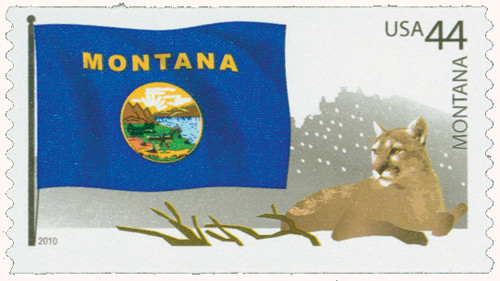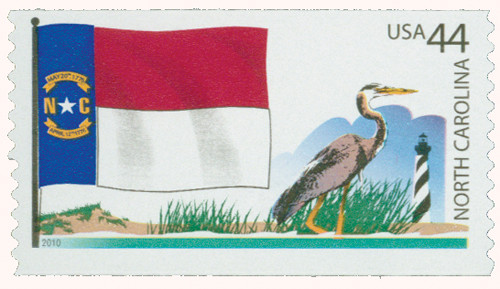U.S. #4303-4312
Flags of Our Nation
Issue Date: April 16, 2010
City: New York, NY
Printing Method: Photogravure
Perforations: Serpentine Die Cut 11 vertically
The Flags of Our Nation stamp series honors each state in our great nation. The coil stamps picture individual state flags along with images that transmit the character of the state being honored.
American Flag and Mountains
The looming mountains straddling the Continental Divide created a barrier that is as physical as it is symbolic. When schoolteacher Katharine Bates looked out from the summit of Colorado’s Pikes Peak and east over the Great Plains, she was moved to write what would become one of America’s most beloved songs, “America the Beautiful.” Around her lay the purple mountain majesties – tall and snowcapped, a direct contrast to the sea of grain below.
The Continental Divide, or “Great Divide,” not only serves as a boundary between East and West, but also determines where North America’s waters flow. It is just one of the continental divides in North America. The Laurentian Divide is an East-West separator that intersects the Great Divide at Triple Divide Peak in Montana. From that point all rain that falls there flows either east to the Atlantic Ocean (counting the Gulf of Mexico), north to the Arctic Ocean, or west to the Pacific Ocean.
The Great Divide was a barrier in the nation’s westward expansion. As the U.S. followed the ideal of “Manifest Destiny” and progressed to an American flag with 50 stars for 50 states, the vast mountain ranges were just one hurdle to overcome.
Montana
The trains pulled out from Dillon, Montana, in 1898, the first step of a voyage carrying the First Montana Regiment to battle. The United States and Spain were at war, and the First Montana was headed to the Philippines, a journey of 7,000 miles. The regiment’s commander, Colonel Harry Kessler, felt the troops needed something special to distinguish them from other units. He privately commissioned a flag for the unit that showed the state seal, with “1st Montana Inft’y U.S.V.” above the seal.
The First Montana finally arrived in Manila – 10 days after the city surrendered. During their tour they served in the Philippine Insurrection that directly followed the war. Upon their return to Montana in 1899, Kessler’s flag captured the attention of the public. Six years later, the Montana state legislature adopted that flag as the official state flag, with the regiment’s name removed.
The seal features a pick, shovel, and plow against a background of forests, fields, and mountains. The Great Falls and Missouri River are also shown. The scene represents Montana’s mineral and agricultural wealth, which is reinforced by a banner that says Oro y Plata, or “Gold and Silver.” In 1981, the state legislature added “Montana” above the seal.
Nebraska
As homesteaders and settlers trickled into Nebraska in the 1860s, they were met by a sea of grass that stretched beyond the horizon. They had heard conflicting descriptions of Nebraska. Major Stephen Long, an early explorer in the 1820s, called the region the “Great American Desert” for its lack of trees and water. Zebulon Pike described it as having “not a stick of timber.”
Decades later, others, such as Professor Samuel Aughey and Charles Dana Wilber, described the state as a garden and declared “Rainfall follows the plow.” That claim inspired an influx of settlers, and soon Nebraska was being plowed. But the prairie grass that served as an anchor for the soil was soon buried. Heavy winds that often swept the plains dried the exposed soil into dust, then lifted it into great rolling clouds called “black blizzards.”
Droughts struck the region in the 1920s and 30s, leading to the nickname, the “Dust Bowl.” Combined with the Great Depression, it meant hard times for Nebraska. But modern farming techniques have helped restore fertility to the plains. This history is commemorated on Nebraska’s flag, which features the state seal on a blue background. The seal showcases the importance of agriculture to the state’s prosperity.
Nevada
The politics of the Civil War weighed heavily in Nevada achieving statehood. There was a rush to grant the territory statehood in order to help President Abraham Lincoln’s re-election bid in 1864. To that end, the entire state constitution was sent by telegraph to Washington, D.C. It was a process that took more than seven hours to transmit. Statehood was gained just eight days before the election, with the Civil War still raging. This led to Nevada’s nickname “Battle Born,” which is featured on the state flag.
Nevada means “snow-covered” in Spanish. But Nevada is a land of contrasts. Most of the state is desert, and almost the entire state lies within the Great Basin desert. The desert is broken by mountain ranges, such as the Sierra Nevada along the western border with California. With 172 mountains at 2,000 feet or more high, Nevada is the most mountainous of the lower 48 states.
Nevada is rich in mineral resources, particularly silver. Discovery of the Comstock Lode in 1857 marked the beginning of large-scale silver mining in America, as settlers rushed to the region to find riches. The industry has made Nevada the second-largest silver-producing state in America, inspiring another nickname – the “Silver State.”
New Hampshire
Portsmouth, New Hampshire, was a thriving center for shipbuilding by the time of the American Revolution. When the Continental Congress decided to create a Navy, the first three ships were built on John Langdon’s shipyard on an island in Portsmouth Bay.
In 1776, the crew at Langdon’s shipyard laid the keel for the USS Raleigh, the first warship of the U.S. Navy. Two months later, the vessel was launched into immediate action against England. After two years of service, the Raleigh ran aground and was seized by the British, a painful loss to New Hampshire and the young nation.
Langdon’s shipyard didn’t stay in New Hampshire long, either. The facility is still in Portsmouth Bay, but in 1820 the island became part of Kittery, Maine, as the new state entered the Union. That was long after the New Hampshire legislature voted in 1784 to make the Raleigh and the shipyard on the island the focus of its state seal.
The topics shown on the seal weren’t the only things to move beyond New Hampshire’s control. Artists often altered the image, adding people or casks of rum. The state finally put an end to the artistic license in 1909, with a law that formalized the design.
New Jersey
New Jersey’s early agricultural heritage is strongly reflected on its state flag, which bears the classical themes found in the state seal. Three plows are on the face of the center shield, which is flanked by Ceres, the Roman Goddess of Agriculture and Plenty. In her arms she carries a cornucopia, a legendary horn holding a never-ending supply of food. The horn holds the fruits and grains that are found in New Jersey.
The flag’s design has the state seal set against a buff-colored background, a pattern influenced by General George Washington. During the American Revolution, Washington ordered Colonial military units to carry two flags – one for the new nation and one for their state flag. That state flag would be in the colors of the “facing” of the troops’ uniforms.
New Jersey’s soldiers wore dark blue uniforms with buff facing, the colors of the Netherlands. The Dutch have a strong history in New Jersey. Along with the Swedes, the Dutch settled the region as early as 1613, until the British took over in 1664. Washington had selected those colors to honor the original Dutch settlers. For more than 200 years, the state flag has flown with those same colors.
New Mexico
The Zia Indians of New Mexico view the number four as very important in their culture. There are four points of the compass, four seasons, four parts to the day (morning, noon, evening, night). They believe that one’s life is divided into four stages – childhood, youth, middle age, and old age. And a person has four sacred obligations to maintain – a strong body, clear mind, pure spirit, and devotion to the welfare of others.
When New Mexico became a state in 1912, the first state flag was a blue field with a small U.S. flag in the top-left corner. The state seal was in the bottom-right corner, with “New Mexico” running from the top-left to bottom-right corners. But a better alternative was soon offered.
In 1920, the Daughters of the American Revolution suggested a design to better represent New Mexico’s unique heritage. They proposed using an ancient symbol for the sun found on a Zia Pueblo water jar in the late 19th century. The resulting flag has a circle that represents the unending cycles of love and life connecting the four points of the sun. The Spanish heritage in the region is acknowledged by using the traditional family colors of Queen Isabella of Spain – red for the design, set on a yellow background.
New York
Two women grace the state flag and seal of New York – one of them named Liberty, and the other called Justice. Justice is blindfolded, with sword and scale in hand to represent impartiality and fairness. Liberty stands with her hair free and unbound, holding a staff with a yellow cap on it.
The staff is similar to what was called a “liberty pole” – a pole erected by American colonists in town squares during the years leading up to the Revolution. When an ensign (flag), or “Phrygian cap,” was placed at its peak, it was a signal for townspeople to meet to discuss issues concerning British rule. These poles often drew the attention of local British troops.
Phrygian caps date back to the Roman Empire. Freed slaves wore the brimless red hats to symbolize their new status as citizens of the empire. This was relevant to American colonists defending their status as full citizens of the British Empire. Yet the image of Liberty holding a symbol of freedom is not unique to the state seal of New York.
Lady Liberty is an important symbol to New York in another way. She is the subject for the Statue of Liberty, who holds up a torch symbolizing enlightened freedom – a gift from France to honor the centennial of the Declaration of Independence.
North Carolina
The belief that America’s most celebrated document, the Declaration of Independence, is the first of its kind expressing America’s break with England is false, according to some North Carolina historians. They say the nation’s most famous document was written a year after the true first separation from England was declared – the Mecklenburg Declaration of Independence.
The Mecklenburg Declaration, called “Mec Dec,” was signed on May 20, 1775, in reaction to the Battles of Concord and Lexington. The group wrote, “...we the citizens of Mecklenburg County, do hereby... absolve ourselves from all bonds to the British Crown.”
Controversy arose about which document came first. The “Mec Dec” was reconstructed following an 1800 fire, and there are many similar phrases to the 1776 Declaration. It was published in the Raleigh Register newspaper in 1819. Most historians believe the “Mec Dec” arose from faulty memories of the participants, who in trying to recreate it after the fire confused it with the Mecklenburg Resolves, a different document protesting British tyranny that was written 11 days later. Still, the North Carolina State Flag proclaims May 20th, 1775, as an important day in state history.
North Dakota
Bismarck became the capital of the North Dakota Territory in 1883. But many residents felt the capital should be moved to the more populous eastern part of the territory. So the official territory records were relocated to Jamestown, which was selected as the new location of the government.
Once a frontier town with a rough reputation, Bismarck sat on the edge of the Badlands, where many outlaws hid out. Theodore Roosevelt hunted criminals as deputy sheriff during the time he lived in the area, which now bears his name as a state park. A town like Bismarck wasn’t ready to accept such a loss in status as territory capital. A group of citizens rode 100 miles through a blizzard, broke into the Stutsman County Court House in Jamestown, took the state records, and brought them back to Bismarck – while avoiding a posse. The records remained there until the state legislature agreed to reconvene in Bismarck.
With the statehouse built there in 1883-84, the issue of Bismarck as capital was effectively over. It remained the seat of government when North Dakota gained statehood in 1889. Still, a small protest remains, as the legislature has never voted to confirm Bismarck as the official state capital.
The Flags Of Our Nation Series
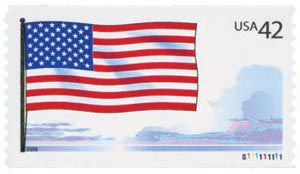
On June 14, 2008, the USPS issued the first set of stamps in its Flags of Our Nation Series.
The state flags had been honored on US stamps once before, in 1976 as part of the Bicentennial Series (US #1633-82). Those stamps marked an important first – they were America’s first 50-stamp se-tenant. The sheet featured all of the state flags in the order the states were admitted to the Union.
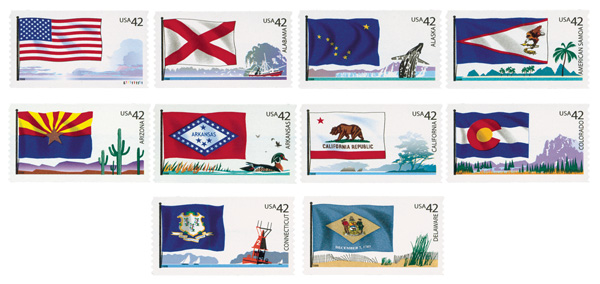
In 2008, the USPS again decided to honor the state flags but in a different format. These stamps represented a US postal first. They have the beauty and historic significance of commemorative stamps, but were issued as se-tenant (face-different attached) definitive coil stamps.
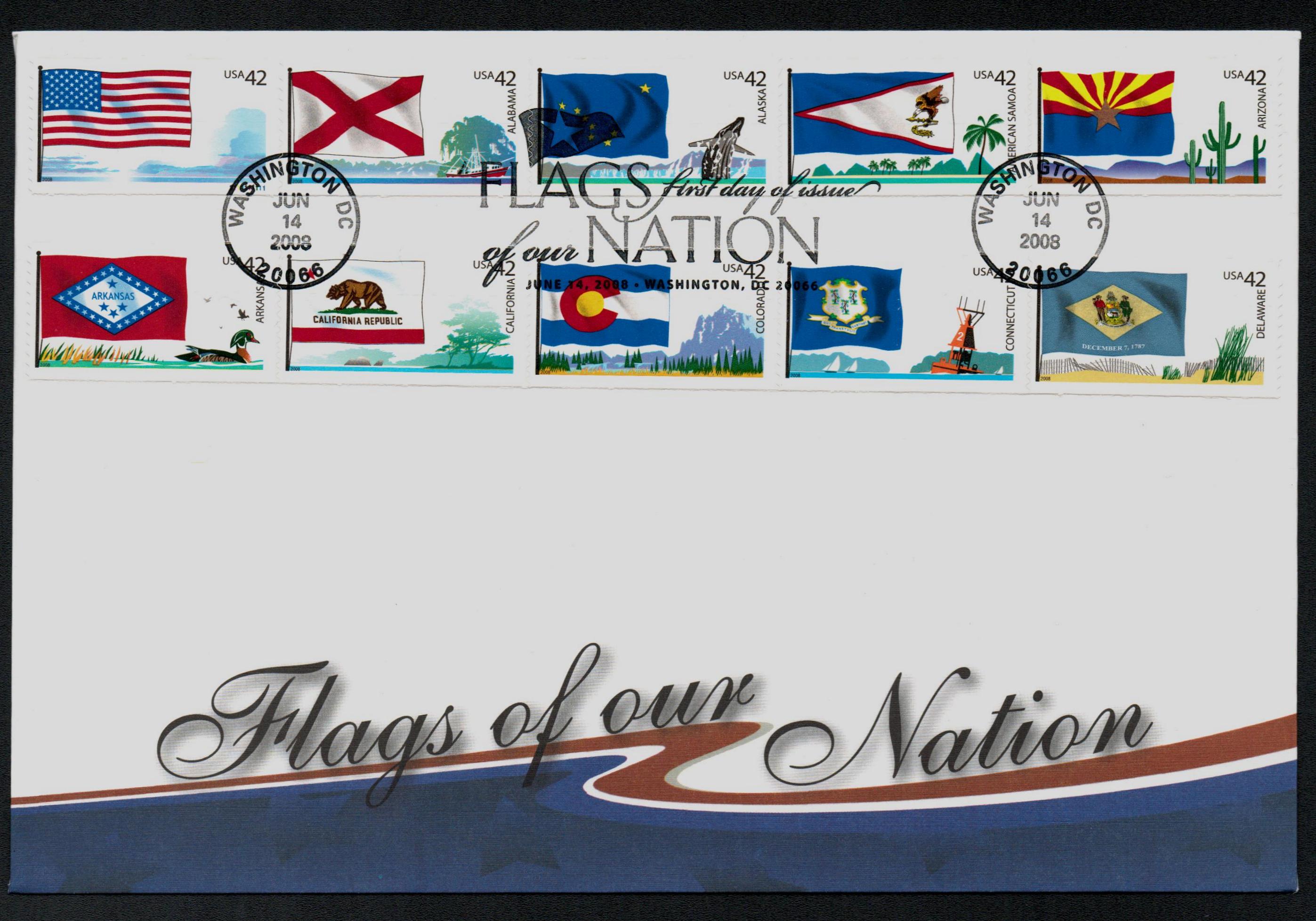
The new series was called “Flags of Our Nation” and would consist of 60 stamps total – 50 featuring state flags, five territorial flags, the District of Columbia flag, and four US flags flying over American landscapes described in “America the Beautiful.” The stamps in the new set would be issued in alphabetical order by state or territory. Each stamp would feature a flag and a “snapshot” from the state or territory. These snapshots would include scenic areas, plants, animals, and more.
The first set of stamps was issued on Flag Day, June 14, 2008 at the National Postal Museum in Washington, DC. It featured the flags of Alabama through Delaware, American Samoa, and the American flag with “spacious skies.”
In speaking about the stamps, a USPS representative said, “Flags are our nation’s greatest symbols for unity and pride and the values we hold dear. The Postal Service is proud to present this tribute as we honor our nation’s flags.” That same day, special events were held in the nine state capitals whose flags were featured in that first set of stamps.
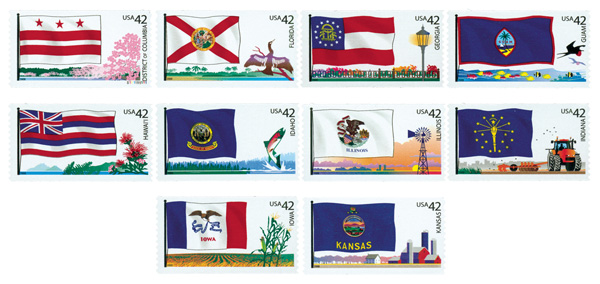
The second set in the series was issued later in 2008, on September 2. As with the first set, there were special ceremonies in the state capitols of those states featured on this set of stamps. The stamps in this set featured the flags of Florida through Kansas, the District of Columbia and Guam.
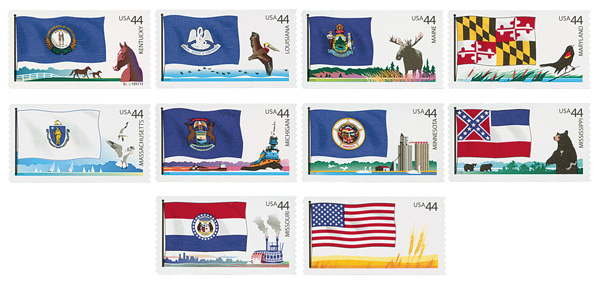
Initially, two sets of 10 stamps were supposed to be issued each year for three years. However, in 2009 it was decided that each year would only include the issue of one set of 10 stamps. The third set was issued on August 6, 2009 at the American Philatelic Society Stamp Show in Pittsburgh, Pennsylvania. These stamps featured the flags of Kentucky through Missouri as well as the US flag with “amber waves of grain.”
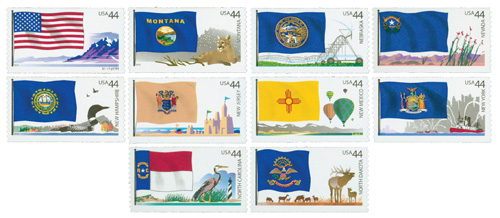
The fourth issue in the series was released on April 16, 2010 at the Mega Stamp Show in New York City. These stamps featured the flags of Montana through North Dakota with the US flag above “purple mountain majesties.”
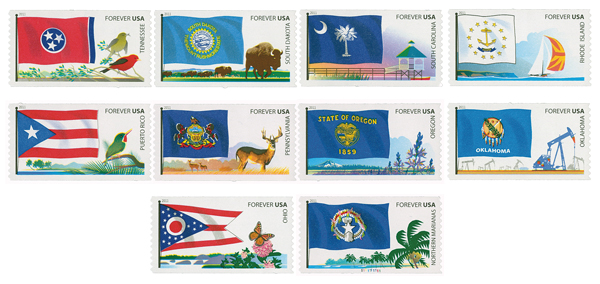
The fifth set was issued on August 11, 2011, at the American Philatelic Society Stamp Show, in Columbus Ohio. These were the first in the series to be issued as Forever stamps. Featured on these stamps were the flags of Ohio through Tennessee, Puerto Rico, and the Northern Mariana Islands.
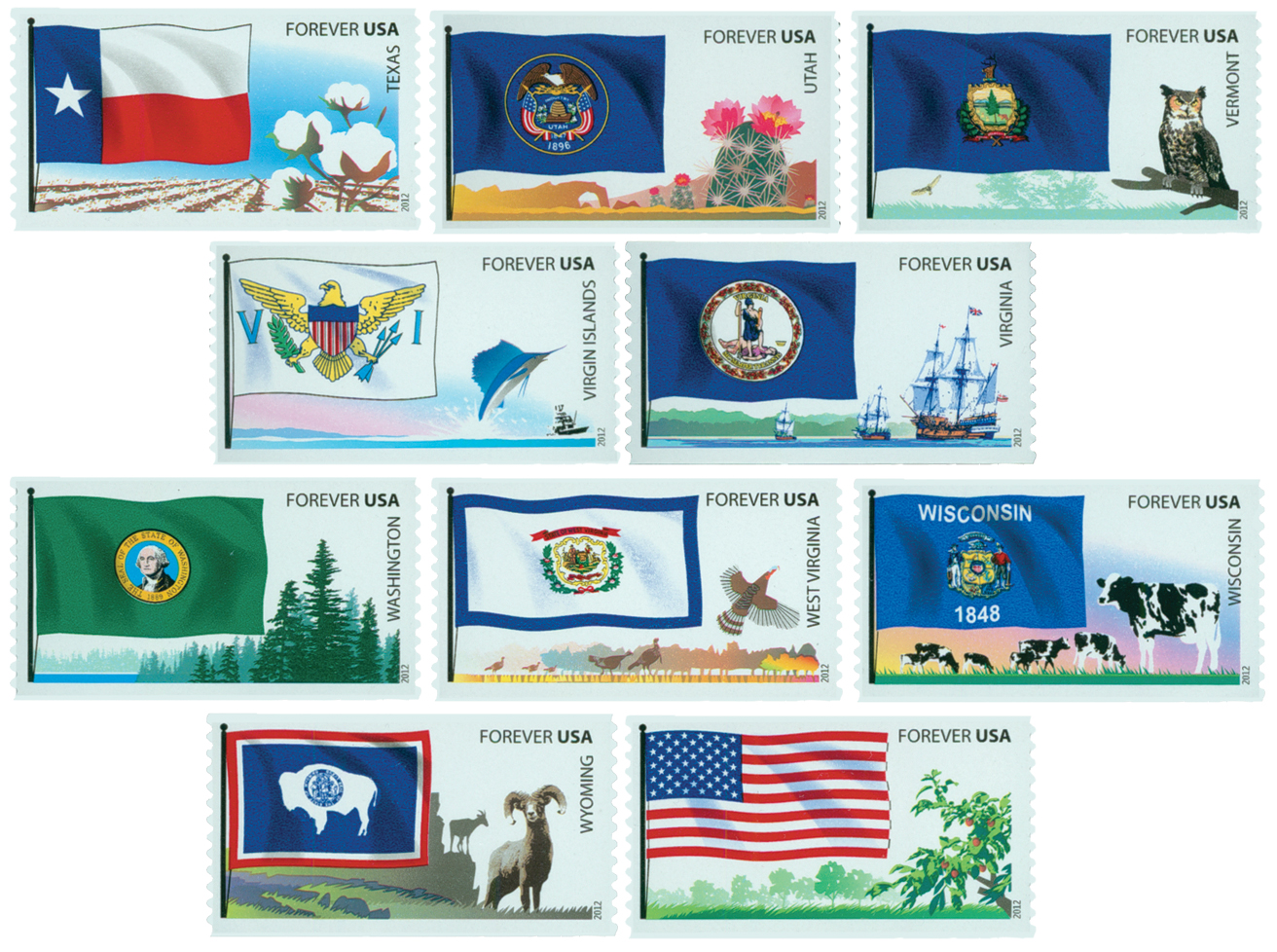
The series came to a close on August 16, 2012, with the sixth and final set. These stamps were issued at the American Philatelic Society Stamp Show in Sacramento, California. Featured on these stamps were the flags of Texas through Wyoming, the Virgin Islands, and the US flag with “the fruited plain.”
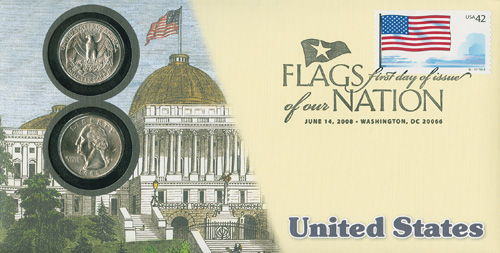
Click here for more Flags of Our Nation Coin Covers as well as single stamps and sets.
Click here to get the complete set of 60 Flags of Our Nation stamps in one convenient set.

























